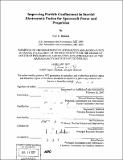Improving particle confinement in inertial electrostatic fusion for spacecraft power and propulsion
Author(s)
Dietrich, Carl, 1977-
DownloadFull printable version (26.72Mb)
Other Contributors
Massachusetts Institute of Technology. Dept. of Aeronautics and Astronautics.
Advisor
Manuel Martinez-Sanchez and Raymond J. Sedwick.
Terms of use
Metadata
Show full item recordAbstract
Fusion energy is attractive for use in future spacecraft because of improved fuel energy density and reduced radioactivity compared with fission power. Unfortunately, the most promising means of generating fusion power on the ground (Tokamak based reactors like ITER and inertial confinement reactors like NIF) require very large and heavy structures for power supplies and magnets, in the case of magnetic confinement, or capacitors and lasers in the case of inertial confinement. The mass of these reactors and support equipment is sufficiently large that no existing or planned heavy-lift vehicle could launch such a reactor, thereby necessitating in-space construction which would substantially increase the cost of the endeavor. The scaling of Inertial Electrostatic Confinement (IEC) is such that high power densities might be achievable in small, light-weight reactors, potentially enabling more rapid, lower cost development of fusion power and propulsion systems for space applications. The primary focus of the research into improving particle and energy confinement in IEC systems is based on the idea of electrostatic ion focusing in a spherically symmetric gridded IEC system. (cont.) Improved ion confinement in this system is achieved by the insertion of multiple concentric grids with appropriately tailored potentials to focus ion beams away from the grid wires. In order to reduce the occurrence of charge exchange and streaming electron power losses, the system is run at high vacuum. This modification to the usual approach was conceived of by Dr. Ray Sedwick and computational modeling has been conducted by Tom McGuire using a variety of custom and commercial codes. In this thesis, a semi-analytic model of the potential structure around a multi-grid IEC device is developed. A 1-D paraxial ray ion beam envelope approximation is then used along an equatorial beamline and the assumed beam density is gradually increased until an effective beam space charge limit is reached at which point the potential fusion output is calculated. Significant use of the commercial particle-in-cell code OOPIC was made, and its ability to predict multi-grid IEC confinement properties is evaluated. An experiment was built to confirm the effectiveness of the multiple-grid structure to improve ion confinement times. It is shown that the multi-grid IEC can improve ion confinement time over the conventional, 2-grid IEC device. The PIC predicted ion bunching mode is also seen in experiment.
Description
Thesis (Ph. D.)--Massachusetts Institute of Technology, Dept. of Aeronautics and Astronautics, 2007. Includes bibliographical references (p. 216-244).
Date issued
2007Department
Massachusetts Institute of Technology. Department of Aeronautics and AstronauticsPublisher
Massachusetts Institute of Technology
Keywords
Aeronautics and Astronautics.